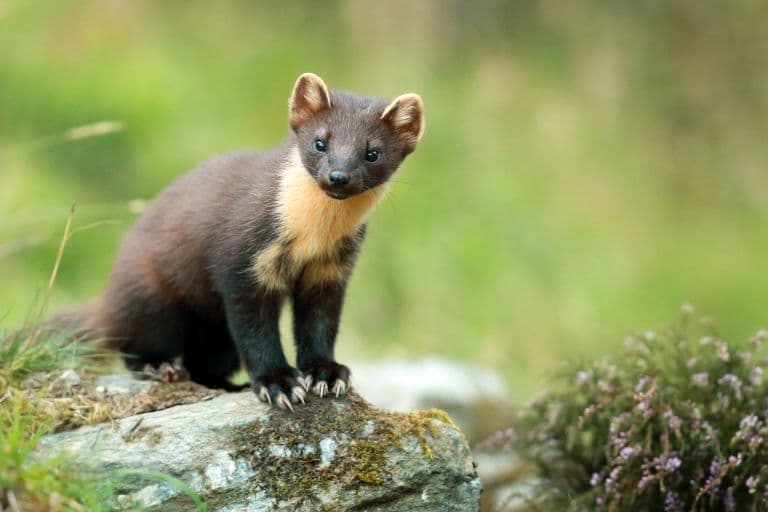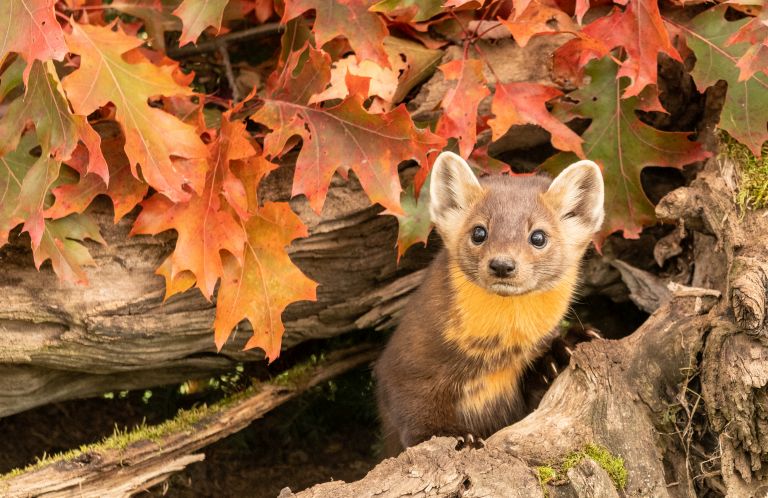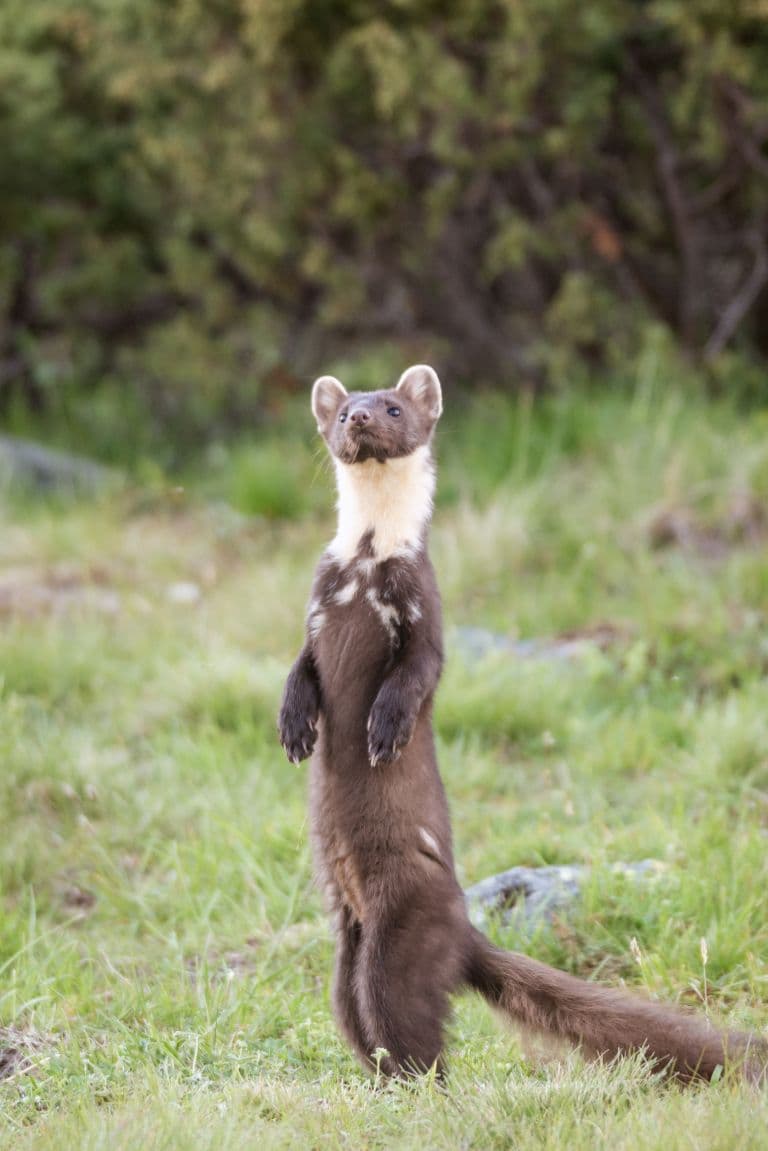European Pine Marten Profile
The Jurassic Park movie used the much larger Deinonychus phenotype to portray its “velociraptors”, misrepresenting the latter as “6ft turkeys” with a “6-inch retractable claw”.
In reality, velociraptors were around half a meter tall, with a mere 6cm claws, and far more kickable than the movie would have led you to believe.
But, small as they were, they were likely exceptionally dangerous, even to much larger animals, and if there’s any doubt as to the power a mesopredator like this can possess, we only have to look at the Mustelids: small-to-medium-sized carnivores like the badgers, stoats, and today’s subjects, the pine martens.
Sometimes known as “sweet martens”, these little predators are more like velociraptors than their rodent size mates, and sweet as they are, they’re also incredibly powerful animals.

European Pine Marten Facts Overview
| Habitat: | Mature deciduous and coniferous forests |
| Location: | Most of Europe, Asia Minor, the Caucasus , parts of the Middle East |
| Lifespan: | 11 years in the wild, 18 in captivity |
| Size: | Up to 58cm (86 cm with tail) |
| Weight: | Up to 1.8kg |
| Colour: | Yellowish-brown to dark brown, with light yellow patch on the throat and chest |
| Diet: | Generalist, omnivorous. Small to medium animals, fruit, vegetation, insects, carrion |
| Predators: | Red foxes, some large raptors, wolverines |
| Top Speed: | Mean speed of 6km/h (3.7 mph) but can run faster |
| No. of Species: | 1 |
| Conservation Status: | Least Concern (IUCN) |
The European pine marten is a widespread mustelid in most of Europe, as well as some of Asia. It’s the national animal of Croatia, and appears on the 1 Euro coin!
They are forest specialists, much tougher than they look, especially on account of them looking cute as a button, but also because they are brutal killers of their trophic tier.
These highly resilient mustelids are even tough enough to recover from the Great British wildlife eradication that’s been ongoing for centuries, making the islands inhospitable to the majority of animals.
Like many in their order, pine martens are not given the honour they deserve, but projects like Back from the Brink hope to restore them to their former glory and join them in eradicating invasive species.
Interesting European Pine Marten Facts
1. They’re tough
Pine martens are harder than they look. A very large individual will max out at under 2kg, and their slender length makes them look delicate, but as mustelids, delicate isn’t an applicable term.
Owners of chickens in pine marten territory will attest to the tenacity, agility and brute strength of these weasel-like predators, and will commonly report that pine martens kill for the sheer enjoyment of it.
Pine martens can tackle prey much heavier than themselves, and can climb into most enclosures to find them. Despite being significantly smaller, martens are one of the few animals tough, fast and agile enough to predate upon hares successfully.
But the pine marten’s toughness doesn’t stop at its strength. These are highly adaptable animals, capable of eating more or less anything and surviving temperatures and terrains that others can’t. This resilience has made them highly successful throughout their range. 1

2. They’re widespread
There are European pine martens all over the Northern landmass from Siberia, through Russia, the British Isles and all the way down to the Mediterranean, including the Balearic and Italian islands.
Undoubtedly, they would have taken over the Americas as well, if it weren’t for their close relatives, Martes americana having already occupied that space.
They’re considered of Least Concern by the IUCN on account of their large and widespread populations, and this success can be attributed to the fact that they’re the epitome of generalist mammals. 2
3. They’re generalists
The majority of a marten’s calories come from animal protein. Mice, voles and squirrels make up a substantial portion of their diet, as do birds, insects, and sometimes even fish.
But martens also love fruit, seeds, beetles, earthworms, and even carrion where they can get it. They’re also keen on birds’ eggs, nuts, and honey, and this means they can survive almost anywhere, thriving on the range of foods that the environment provides.
And this range isn’t limited to different populations; individual martens will adapt their diet as necessary, varying their intake by season and location. 3
4. They have semi-retractible claws
Martens are exceptional climbers, which adds to their rugged independence. They spend a lot of time in trees, running along narrow branches and scaling trunks with highly-adapted claws that are semi-retractible.
These are the only mustelids with this feature, and it clearly gives them an edge. Their sensitive ears and powerful bite complement their other abilities to create a relentless, intelligent, powerful killer.

5. They’ll kill cats
To put their power into perspective, domestic house cats and pine martens come into conflict on occasion, and the marten is often the one who comes out on top.
John Lawrence, writing under the pseudonym William Henry Scott published a book called British Field Sports in 1818, in which he talks at length about the marten. He describes it as having,
“… the body of a Weasel with the head and tail of a Fox, excepting the ears, which are rounded”.
Lawrence goes on to say,
“The Marten is said to be the natural Enemy of the common Cat, and that when these Greeks meet, the tug never fails to be mortal, and the Marten is generally the survivor.
They are dreadful enemies to Pheasants, pulling them down at roost, and if suffered to increase near a Preserve, would soon thin the most abundant. Like perhaps all, or most other wild Animals, they may be tamed and domesticated, as has been said of the Fox; but they retain a certain occasional savage capriciousness, which would perhaps pass off in a few generations.”
6. They exhibit delayed implantation
If you thought these animals couldn’t be any better adapted to survive, they have even more up their sleeve.
Breeding in martens involves a mating period that occurs almost a year before birth. Females take advantage of the season to mate but then can delay implantation until a more opportune time, allowing them to give birth in April or May, at the beginning of the seasonal abundance.
This breeding strategy adds yet another layer to this species’ survival skills and makes it a shoo-in for repopulating even the most hostile of environments.
7. Pine martens can stand on two legs
They do this to be able to smell the air and see their surroundings when looking for prey, or looking out for potential threats.

8. They’re back in the UK
The UK is one of the world’s most nature-depleted countries. One in six species has been entirely eradicated by rampant misuse of land and the relentless habitat destruction, pollution, and fragmentation that comes with it. In the last 40 years or so, wildlife abundance has declined by around one-third, and many more species are threatened by extinction in a country that shows no signs of slowing down its rampage against nature.
Pine martens were long thought to be extinct in England, like many other animals, but in 2010, hard, sticky evidence (poo) was found of their presence, and in 2022, the first video footage of one was recorded in Grizdale forest.
This would be the first confirmed sighting of a pine marten in England in over a century, and it may have migrated back over from Wales. There’s also a healthy population of around 4000 in Scotland, and between them, the country might stand a chance at supporting the declining red squirrel populations. 4
9. They can help with the fight against American squirrels
Like so many American imports, the Grey squirrel in Britain is bigger, noisier, and more environmentally damaging than their native red squirrel counterparts.
Bringing with them colonial diseases like squirrel pox, and out-competing the smaller red squirrels, they’ve generally done a good job of removing the native squirrels from all but the northernmost locations in Britain.
In Ireland, the recovery of pine marten populations has been attributed to a rapid decline in invasive grey squirrels. This suggests that the marten might play a role in protecting the more arboreal and native red squirrel by eating the fatter and more terrestrial grey squirrels that are easier to catch.
And conservationists are taking notes! 5 6
10. A Pine marten once invaded a football match
A Swiss football match was once thrown into chaos when a pine marten ran onto the pitch. It was caught by a Zurich defender, who was bitten for his troubles!
European Pine Marten Fact-File Summary
Scientific Classification
| Kingdom: | Animalia |
| Phylum: | Chordata |
| Class: | Mammalia |
| Order: | Carnivora |
| Family: | Mustelidae |
| Genus: | Marte |
| Species: | Marte Martes |
Fact Sources & References
- “PINE MARTEN”, Woodland Trust.
- “Pine marten”, Trees for Life.
- Anna Maria De Marinis (1995), “Feeding habits of the pine marten Martes martes L., 1758, in Europe: a review”, Hystrix.
- (2015), “Shropshire pine marten sighting is the first in a century”, BBC News.
- (2015), “Pine Marten Recovery Projects”, Vincent Wildlife Trust.
- Emma Sheehy (2014), “Population crash in an invasive species following the recovery of a native predator: The case of the American grey squirrel and the European pine marten in Ireland”, Research Gate.
